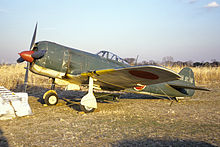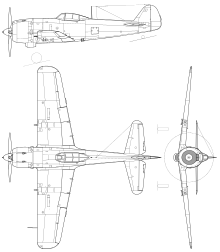Nakajima Ki-84
| Nakajima Ki-84 | |
|---|---|

|
|
| Type: | Fighter plane |
| Design country: | |
| Manufacturer: | |
| First flight: |
April 1943 |
| Number of pieces: |
3,514 |
The Nakajima Ki-84 Hayate ( Japanese 四 式 戦 闘 機 「疾風」 , Yon-shiki sentōki "Hayate" , German fighter type 4 storm wind ), allied code name: Frank , was the most powerful fighter of the Japanese Army Air Force in the last year of the Pacific War . Like the previous models produced by Nakajima was the Ki-84, a self-supporting all-metal - low-wing monoplane with retractable landing gear and air-cooled radial engine.
The Ki-84 achieved similar flight performance as its opponents, e.g. B. the Chance Vought F4U or the North American P-51 . While the top speed did not quite reach the level of the American fighters, the Ki-84 was significantly more agile due to its low weight and could also climb better. However, the performance potential of the type could not be fully exploited due to the lack of high-octane aviation fuel. Towards the end of the war, the Japanese Army Air Force only had low-octane aviation fuel, which limited the usable boost pressure and thus the engine power.
Japan needed this aircraft so badly in the final months of the war that it was planned to manufacture 200 of this type per month in underground factories.
The history of origin
The planning of the Ki-84 began shortly after the unleashing of the Pacific War. It should be the answer to the fighters developed in the USA and serve as the successor to the Nakajima Ki-43 .
The Japanese Army Air Force required the Ki-84 to have the maneuverability of the Ki-43 and the speed and climbing ability of the Ki-44 . At the same time, the aircraft should be equipped with armor and self-sealing fuel tanks.
An air-cooled 18-cylinder double radial engine Nakajima Ha-45 with 1926 hp was to be used as the engine. Two 12.7 mm Type 1 machine guns (Ho-103) and two 20 mm Ho-5 cannons formed the armament of the planned Ki-84.
The size and design of the Ki-84 corresponded roughly to those of the very successful Ki-43 also manufactured by Nakajima; the improved performance was mainly achieved through the considerably more powerful engine.
In April 1943, the prototype of the Ki-84 took off from the Ojima air base on its first flight. After a few modifications, the fourth prototype reached a speed of 634 km / h at an altitude of 6650 m in straight flight. In a dive, speeds of 798 km / h could be reached.
In October 1943 further tests of the Ki-84 took place under operational conditions. The missions were very satisfactory for everyone, and series production began under the designation Ki-84-Ia.
Mission history
In addition to its role as an interceptor, the Ki-84 also achieved considerable success as a dive fighter aircraft and on long-range missions. Even if the Ki-84 was originally developed for the offensive, it was used to protect the Japanese core islands due to the situation in Japan in the last weeks of the war. On April 15, 1945, eleven Ki-84s carried out a surprise attack on the US airfield on Okinawa. A significant number of US planes were destroyed, but only three of the eleven planes returned.
Other areas of application in addition to the Japanese core islands were the Philippines, Okinawa, Taiwan and South-East Asia.
The engine performance of the Ki-84 remained limited, as all Homare engines used in the operational versions were limited to 2900 rpm at +250 mm Hg boost pressure. The prototypes had been tested with significantly higher engine power at 3000 rpm and +350 mm Hg boost pressure. Despite detailed improvements compared to the prototypes - in particular the introduction of individual exhaust nozzles to use the thrust of the exhaust gas jet to increase speed - the top speed of the Ki-84 remained relatively low at 624 km / h at a height of around 6.5 kilometers. Despite the weaknesses at high to medium altitudes, the Allies regarded the Ki-84 as a serious enemy, especially at low altitudes.
There were big problems with the quality. The Japanese economy was in dire straits. The material required for aircraft construction could often - if at all - only be provided with a delay. The industry has been targeted by US bombers, especially in recent months. Japan was no longer able to produce enough high-performance steel that combined toughness, breaking strength, and fatigue resistance on the one hand, and hardness on the other. In addition, experienced workers were called up for military service, as was the case in the German Reich. As a result, the quality of the aircraft suffered enormously; the performance decreased from aircraft to aircraft and the technology became more unreliable. Often there were defects in the hydraulics or the injection system of the engine or defects due to the poor quality of the steel. Another source of error was that the chassis often broke due to poor material quality and fatigue. Many of the Ki-84s were therefore destroyed on landing without having to suffer even the slightest damage in aerial combat.
Versions
| Parameter | Data Ki-84-Ia, Ib, Ic |
|---|---|
| length | 9.92 m |
| span | 11.24 m |
| height | 3.39 m |
| Empty mass | 2,659 kg |
| Takeoff mass | 3,608 kg |
| Max. Takeoff mass | 3,890 kg |
| drive | Nakajima Ha-45 Model 11 (1825 PS TO) Nakajima Ha-45 Model 12 (1850 PS TO) Nakajima Ha-45 Model 21 (2018 PS TO) Nakajima Ha-45 Model 23 (1926 PS TO) |
| Top speed | 631 km / h at 6,120 m |
| Cruising speed | 446 km / h |
| Service ceiling | 10,500 m |
| Max. Range | 2,168 km |
| Armament | two 12.7-mm-Ho-103-MGs, two 20-mm-Ho-5-cannons (Ia) four 20-mm-Ho-5-cannons (Ib) two 20-mm-Ho-5-cannons, two 30 mm Ho-105 guns (Ic) |
| additionally | two 250 kg bombs or two additional tanks |
The Ki-84-II was identical to the Ki-84-I, except that the rear fuselage, some fittings and the wing tips were made of wood, so the following table only lists the differences to the Ki-84-I .
| Parameter | Data Ki-84-II |
|---|---|
| Max. Takeoff mass | 3,853 kg |
| drive | Nakajima Ha-45 Model 21 (2018 PS TO) Nakajima Ha-45 Model 23 (1926 PS TO) Nakajima Ha-45 Model 25 (2028 PS TO) |
| Top speed | 669 km / h |
| Service ceiling | 10,500 m |
| Max. Range | 2,170 km |
| Armament | four 20 mm Ho-5 cannons or two 20 mm Ho-5 cannons, two 30 mm Ho-105 cannons |
| additionally | two 250 kg bombs or two additional tanks |
Never built, flown or used
Ki-84-III
The Ki-84-III was intended for use at very great heights; However, the end of the war came before that, a prototype was not built. The Nakajima Ha-45-Ru, which was equipped with a turbocharger, was to be used.
Ki-106
To save aluminum, this version of the Ki-84 was built entirely from wood. The Nakajima Ha-45 Model 21 was used as the drive. However, the weight increased by almost 280 kilograms due to the use of wood, which had a negative effect on the curve and climb rate. Only three prototypes of this type were built.
Ki-113
In this version of the Ki-84-Ib, steel was used in many places to save aluminum. However, the prototype never took off due to massive weight problems.
Ki-116
Because of the reliability problems with the Nakajima Ha-45, a Mitsubishi Ha-33 Model 62 with 1520 hp was used for a Ki-84-I. Since this engine was much lighter than the Nakajima, the engine mount had to be lengthened to maintain the center of gravity. At the same time the stern was modified. Overall, this saved almost 450 kg in weight compared to the normal Ki-84. A prototype was built, but the project was stopped when the war ended.
Ki-84N (Ki-117)
The N version was designed as an interceptor for high altitudes. The wing area was enlarged and a more powerful Nakajima Ha-44 model 13 engine with 2535 hp was used. At the end of the war, this type was still in the planning stage.
Ki-84P
This was another high altitude interceptor. The only difference to the Ki-84N was that the wings were enlarged again. Development was discontinued in favor of the Ki-84N.
Ki-84R
Another version for great heights, which was identical to the Ki-84-I. However, the 2028 hp Nakajima Ha-45 Model 44 was used as the engine, which also had a two-stage compressor. However, the construction of the prototype was no longer completed.

